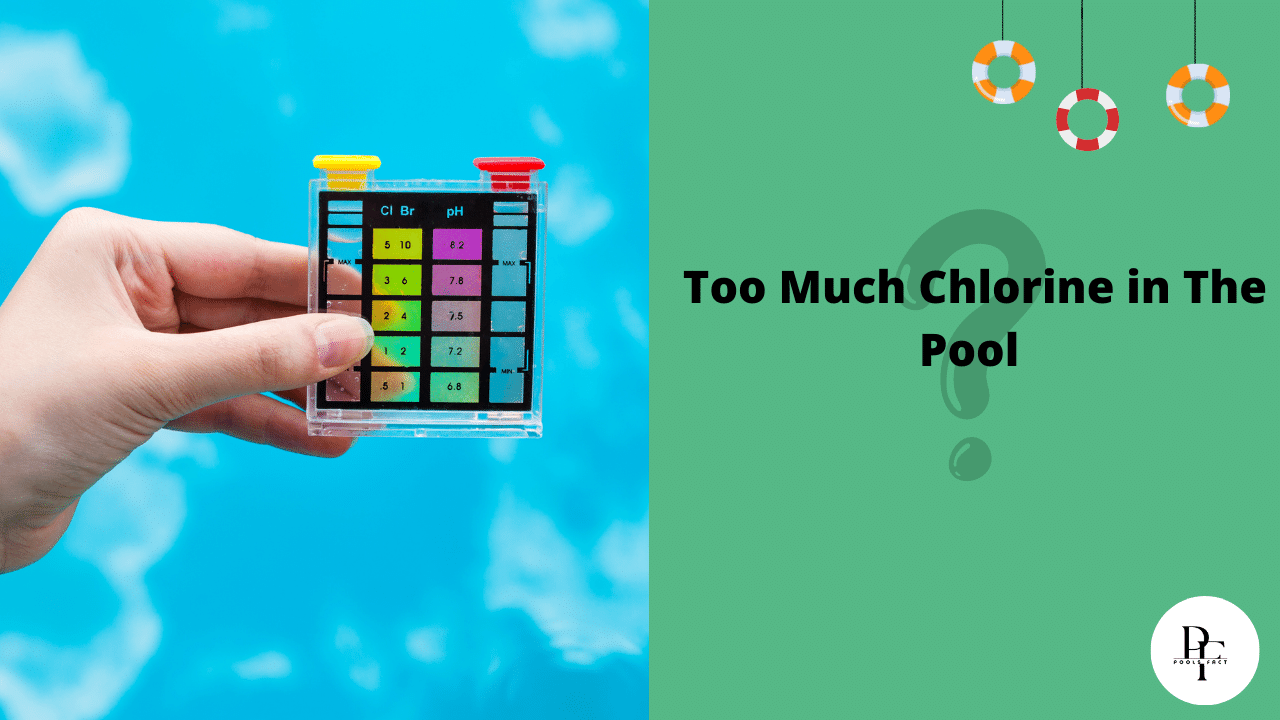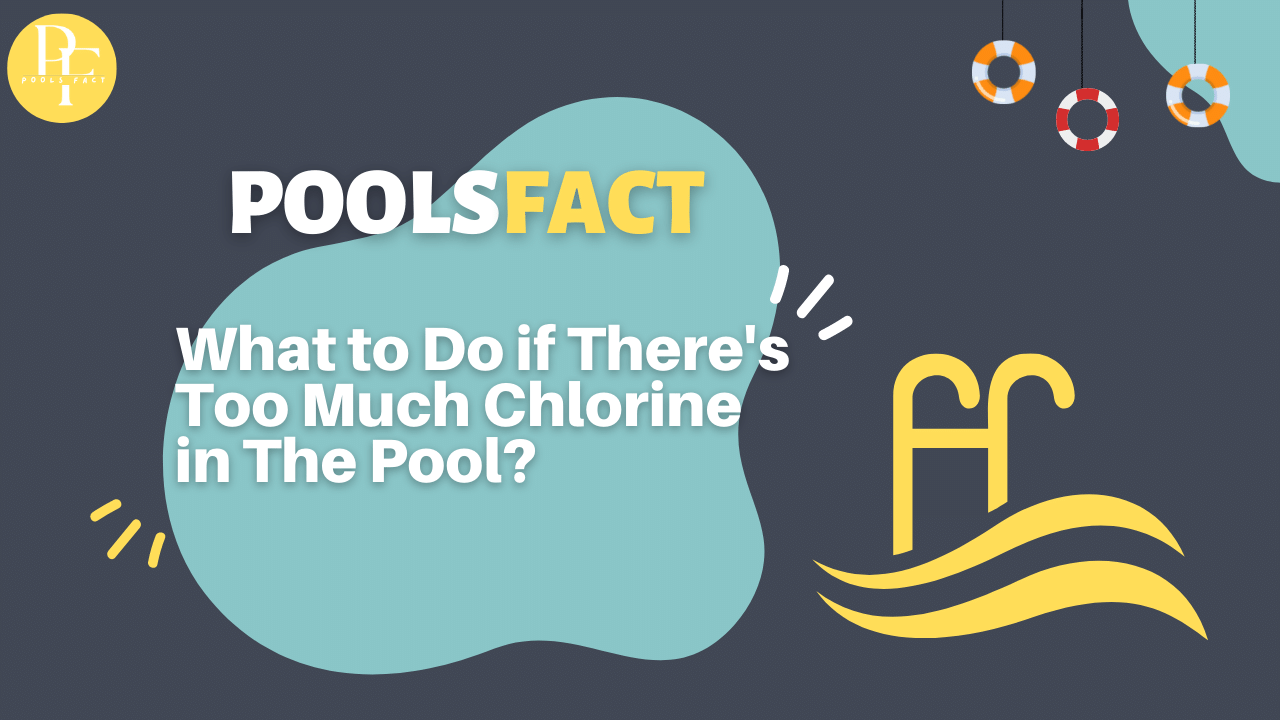A swimming pool upkeep might be challenging. There are mechanical issues to resolve, plumbing to maintain, walls to keep spotless, and chemistry too. Chlorine levels, in particular, may appear difficult to balance in your pool’s chemistry.
It might seem that adding more chlorine will make the pool cleaner, right? In reality, there is a happy medium, and we are here to help you discover it. Therefore, if you need a quick repair after accidentally over-chlorinating your pool, look no further! Let’s return your pool to its ideal state.
How Do You Know if There Is Too Much Chlorine in The Pool?
There are many causes of excessive chlorine levels in swimming pools. Perhaps you accidentally added a little too much after a sizable outdoor BBQ and startled your pool. Maybe you left many too many chlorine tablets in the dispenser while you went on vacation.

Many pool owners add cyanuric acid to their pools to shield the chlorine’s chemical makeup from the sun’s harsh rays, preventing the chlorine from degrading as quickly. A pool that has been over-chlorinated is the result of adding too much chlorine and a little cyanuric acid.
Regarding the sun… There is a fair probability that the chlorine you are applying may not be burning off as quickly as a pool in direct sunlight if your pool is located in a nice dark area in the corner of your garden and almost always receives sun. In the future, you might not need to add as much to maintain your levels where they should be.
Over-Chlorination Risks
We are going to answer the question “does chlorine raise or lower PH?” because we are aware that it will cross your mind. While exposure to a pool that is overly chlorinated can be harmful to your health and well-being, slightly higher-than-normal chlorine levels in your pool are safe.
The pH of the pool’s water can be changed by too much chlorine level, increasing the acidity. Any of the following symptoms could result from high acid levels:
- A red skin rash called irritant dermatitis is characterized by raised, irritating red pimples,
- Overly dilated blood vessels and eye irritation
- Asthma and respiratory conditions brought on by too much chlorine vapor on the pool’s surface
The respiratory tract becomes susceptible to chlorine after continuous exposure to overly chlorinated pools, which is when respiratory issues generally arise. Within a few days to a week, the majority of these symptoms go away on their own without the need for therapy.
Chlorine poisoning can also be brought on by significant over-chlorination, albeit it is extremely uncommon. Chlorine poisoning can cause the following signs and symptoms:
- Nausea and diarrhea
- The feeling of burning in the throat
- Dizziness
- shallow breathing and wheezing
- ongoing coughing
- chest tightness or discomfort.
Contact your doctor right away if you or anybody else who has used your pool experiences these symptoms in case medical attention is required.
Extreme pH shifts may also have an impact on your pool’s chlorine system. Most effectively, chlorine reacts with water that has a pH balance of 7.4 to 7.6. Efficiency drops to under 20% if the pool has a pH of 8.0 or is too alkaline.
Additionally, swimming pool equipment, landscaping elements, clothing, towels, and swimsuits can all be harmed by an improper pH level. To maintain the proper pH level in your pool, it’s critical to add the optimum amount of chlorine. A quick pH strip test can be used to determine the pH of your pool.
If you’re still having trouble achieving a pH balance between alkaline and acid, try adding sodium bisulfate or muriatic acid to your solution. Simply adding seven to nine pounds of baking soda to your pool water can raise the pH levels. Large canisters of baking soda are provided by pool providers for pool pH balancing.
Also Read: How to Dissolve Pool Stabilizer? Guide to Cyanuric Stabilizers
How to Lower the Chlorine Level in A Pool?
1. Stop Adding Chlorine and Get in The Water
If the chlorine levels in your pool are just a little bit higher than what is recommended, you can lower the chlorine levels by not adding any more chlorine in the pool.
Remove the chlorine floater from the pool, turn off your chlorine feeder, or take the chlorine tablets out of the skimmer. The chlorine in your pool can be used up if you stop adding new chlorine on a regular basis.
Swimming in the pool can help speed up the process of removing the microorganisms brought in by the swimmers.
2. Allow Some of The Chlorine to Be Oxidized by The Sun
Your chlorine levels might drop by up to 90% after a few hours in the sun. Just watch that your chlorine level doesn’t fall below the 1 to 3 parts per million limit that is advised.
This might not work as well if you stabilize your chlorine with cyanuric acid. Keep in mind that CYA shields chlorine from photolysis by the sun.
3. Include Hydrogen Peroxide
Since hydrogen peroxide is marketed as a pool chemical oxidizer, its oxidases chlorine by undergoing chemical reactions. Since the human-grade hydrogen peroxide is insufficient for the job, you’ll need to purchase food-grade (35%) hydrogen peroxide that is developed specifically for pools.
4. Empty the Pool of Water and Fill It Up
Draining and re-filling some of the pool’s water is another choice if time is not an issue. Remember: the chemical balance of your pool may be impacted (pH, alkalinity, calcium hardness). Here are some recommendations in case you decide to drain and replenish your pool:
- 13 to 2 of the pool’s water should be drained and replaced. Do not ever drain your entire pool if it has a liner.
- To replenish the water in the pool, insert one or more garden hoses into the side.
- The chemical levels should be tested and then adjusted.
- It may take some time for chlorine levels to return to normal.
5. Add a Chlorine Neutralizer
A chlorine neutralizer may be the ideal quick remedy for you if you’re short on time and don’t mind spending a little money. You can get one at your local pool supply shop.
To that end, before making a purchase, do your homework on the goods and read reviews. Products vary in how well they function.
Leslie Pools Chlorine Neutralizer is recommended.
You might need to use more than one treatment, depending on how much chlorine is in your water. In order to reduce the chlorine in your pool using a neutralizer, make sure you adhere to all manufacturer recommendations that are provided.
Also Read: How to Increase Suction in Pool Skimmers? Remove Unwanted Particles
What Is the Ideal Level of Chlorine in A Swimming Pool?
To kill bacteria, chlorine is added to the water. However, it does not function immediately away. When handled correctly, free chlorine* can destroy the majority of bacteria in a matter of minutes. The CDC advises maintaining a pH of 7.2–7.8 and free chlorine levels of at least 1 ppm in swimming pools and 3 ppm in hot tubs and spas.
How to Reduce Pool Chlorine Usage
What if, in the future, you decide to start chlorinating your pool less frequently? There are a few strategies to cut back on your chlorine usage, though.
1. Add a Mineral System First
Silver and copper are two minerals that can destroy bacteria and let you use up to 50% less chlorine. Only 0.5 to 1 part per million of chlorine is required in mineral systems.
Another benefit? It’s simple to use them. You can insert the dispenser directly into the skimmer basket using an in-skimmer pool mineral system. These can sterilize pools with a capacity of up to 30,000 gallons and last for around six months.
2. Change to A Saltwater System
By producing chlorine, yourself with salt, you can completely cease purchasing it. Yes, saltwater pools are chlorine pools in disguise.
A saltwater generator that is a part of your filter system processes the salt that has been added to the pool water. Chlorine is created from that salt. Also, saltwater systems check your chlorine levels constantly and keep them at 3 parts per million.
So even though you officially have a chlorinated pool, you’re actually adding salt to your system.
You’ll also get your FREE cheat sheet on pool maintenance. If you found this post helpful, you can Follow us to get more tutorials on pool maintenance for the whole season.

Leave a Reply